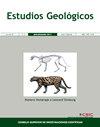基于介形虫组合的塞尼塞罗段冲积沉积物古环境分析(下中新世,非埃布罗盆地)
IF 0.8
4区 地球科学
Q3 GEOLOGY
引用次数: 2
摘要
在这项工作中,我们首次对Ebro盆地NW段Cenicero剖面中新世下冲积矿床进行了古环境和生物地层分析;伊比利亚半岛北部),以介形虫和微哺乳动物组合为基础。该剖面的主要特征之一是,与欧洲其他年代和沉积环境相似的层序相比,研究样品中非改造介形类的丰度不同寻常。这一事实使我们能够进行精确的古环境重建。以laevis、ilycypris bradyi、ilycypris gibba、Limnocythere sp.或Pseudocandona parallela等物种定义的介形类组合的变化记录了远端冲积和/或洪泛平原环境中小型、短暂和浅池塘的发育。在该剖面的上部,池塘似乎不那么短暂,因为水生系统对介形虫的发育更稳定。在剖面上观察到水温和盐度的变化,这与当地降水变化有关。另一方面,其中一个研究样本中存在的微型哺乳动物使得这部分的年代精确。因此,Armantomys daamsi的存在将Cenicero剖面定为Agenian(下中新世),局部带Y2 (MN2)。本文章由计算机程序翻译,如有差异,请以英文原文为准。
Análisis paleoambiental de los depósitos aluviales de la sección de Cenicero a partir de las asociaciones de ostrácodos (Mioceno inferior, NO de la Cuenca del Ebro)
In this work we perform for the first time a palaeoenvironmental and biostratigraphic analysis of the lower Miocene alluvial deposits of the Cenicero section (NW sector of the Ebro Basin; N Iberian Peninsula), based on the ostracod and micromammal assemblages. One of the main characteristics of this section is the unusual abundance on non-reworked ostracods present in the studied samples compared to other European sequences of similar age and sedimentary environment. This fact has allowed us to develop precise palaeoenvironmental reconstructions. The variations of the identified ostracod assemblages, defined by species such as Cyclocypris laevis, Ilyocypris bradyi, Ilyocypris gibba, Limnocythere sp. or Pseudocandona parallela , record the development of small, ephem-eral and shallow ponds in a distal alluvial and/or floodplain environment. Towards the upper part of the section the ponds appear to be less ephemeral, being the aquatic systems more stable for ostracods development. Variations in the water temperature and salinity have been observed along the section, which are related to changes in the local pluviometric regime. On the other hand, the presence of micromammals in one of the studied samples has allowed the precise dating of this section. Thus, the presence of Armantomys daamsi dates the Cenicero section as Agenian (lower Miocene), local zone Y2 (MN2).
求助全文
通过发布文献求助,成功后即可免费获取论文全文。
去求助
来源期刊

Estudios Geologicos-Madrid
GEOLOGY-
CiteScore
1.40
自引率
14.30%
发文量
6
审稿时长
>12 weeks
期刊介绍:
Since 1945 Estudios Geologicos publishes original research works, as well as reviews, about any topic on Earth Sciences.
Estudios Geologicos is published as one yearly volume, divided into two half-yearly issues. It is edited by the Spanish National Research Council (Consejo Superior de Investigaciones Científicas, CSIC) at the Instituto de Geociencias (CSIC-UCM).
Estudios Geologicos provides free access to full-text articles through this electronic edition. Accepted articles appear online as "Forthcoming articles" as soon as the galley proofs have been approved by the authors and the Editor-in-Chief. No changes can be made after online publication.
 求助内容:
求助内容: 应助结果提醒方式:
应助结果提醒方式:


